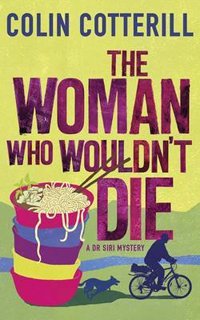
If you’re new to the author, Cotterill’s special brand of noir may require a caveat or two. The Dr Siri Paiboun series of novels are essentially police procedurals, replete with thrills, suspense, and brutal murders. But here’s the thing. They are hilariously funny, deeply humane, and firmly grounded in the supernatural. The Cotterill library of noodle noir, which includes his new Jim Juree mystery series, serves equally well as a travel guide to the land, culture, and cuisine of Laos.
The Woman Who Wouldn’t Die is the ninth installment in the series. Laos is under Communist rule and Siri Paiboun, a doctor, Sorbonne scholar, and disillusioned idealist, expects a well-deserved retirement as a dutiful party member. Instead, the higher-ups appoint him the Party’s official coroner. Although he loves a good mystery, he discovers that his real function is damage control when the authorities need to deal with a high-profile death. In Communist Laos, one’s survival depends less on rusty Soviet weapons than on guile and a sense of humour to avoid the threat of re-education camps or worse, state-sanctioned disappearance. Dr. Siri’s investigative team includes an overqualified nurse, an assistant with Down’s Syndrome, a former revolutionary, and an insider police inspector. They are more like a family than detective unit.
As The Woman Who Wouldn’t Die opens, the aged coroner is not so reluctant to travel to yet another remote jungle. He is excited by the prospect of a genuine clairvoyant helping him with one of his biggest problems – he often sees the spirits of the dead, but he can’t talk to them. These spirits turn up unexpectedly to give him clues concerning his murder cases that are so vague that they only become clear after he solves them. Siri’s body is also inhabited by the spirit of a 1000-year-old shaman whose reticence is no help at all in the struggle to develop his gift. He finds himself closed off in the midst of the spirit world like someone watching television with the sound off.
As Siri’s wife, Madame Daeng, the former revolutionary turned noodle shop proprietor, is naturally jealous of the witch, but becomes genuinely suspicious of her true nature. Meanwhile, a dejected homicidal lover from Daeng’s past is making inquiries about her in the local villages in order to enact bloody revenge. The killer’s motives are illuminated by entries from Daeng’s memoirs, where loyal readers of the Dr Siri series finally get a glimpse of her colourful past as a secret agent. As Siri heads up river, his team launches a parallel investigation to verify the alleged witch’s past while Daeng’s stalker wreaks havoc on Siri’s village.
When it looks like the puzzle of the missing body and the identity of the witch may form part of a larger scheme involving old war secrets, the story’s final act involves no less than 15 elephants, 1000 forest spirits, and an army of Vietnamese engineers. Siri has another strange vision, and this time the denizens of the spirit world are finally communicating. Just as the paths of all the characters converge at the Mekhong River, so the threads of the story come together to reveal that nothing is what is seems and not everyone survives the revelations.
Cotterill’s best yet, this is recommended for fans of whodunits in exotic locales who don’t mind their forensics flavored with Indochinese history and superstition, and a detective who gives them a belly laugh or two.
Quercus
Print/Kindle/iBook
£7.12
CFL Rating: 5 Stars